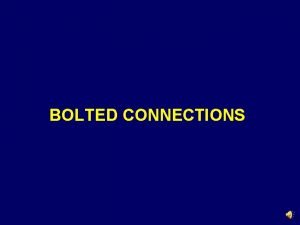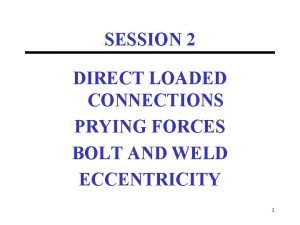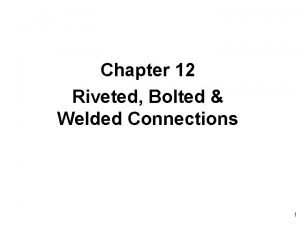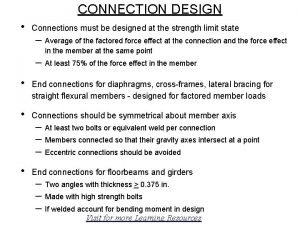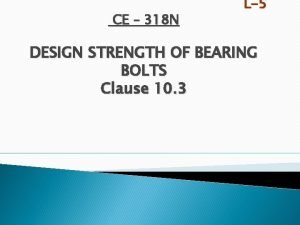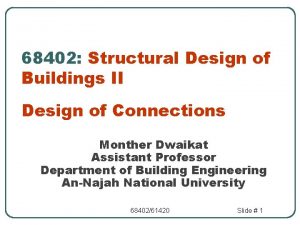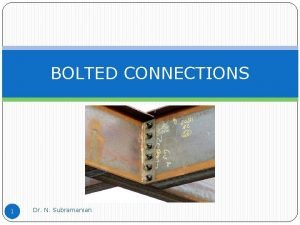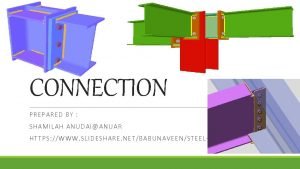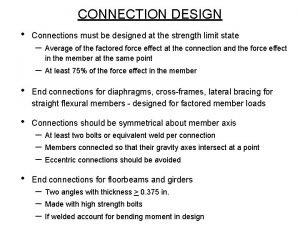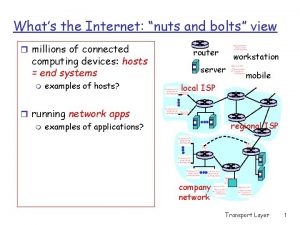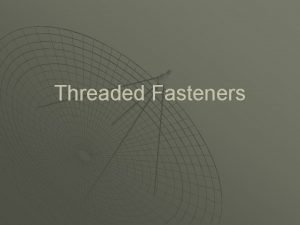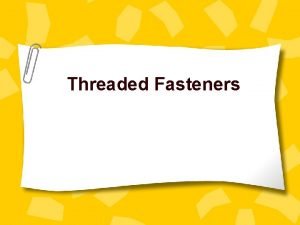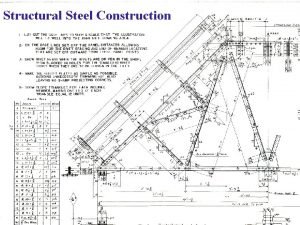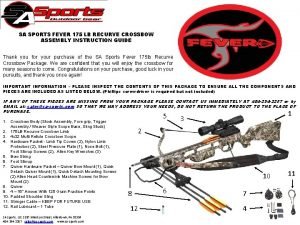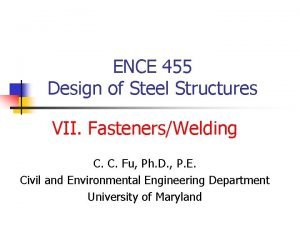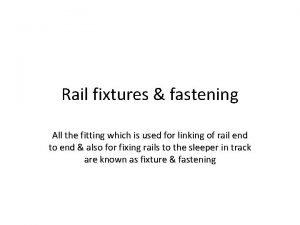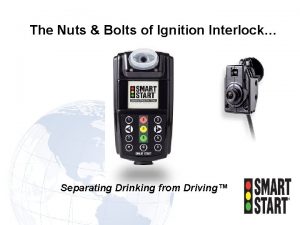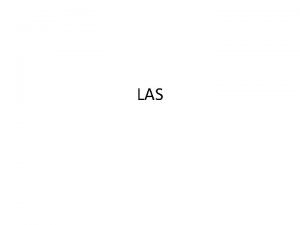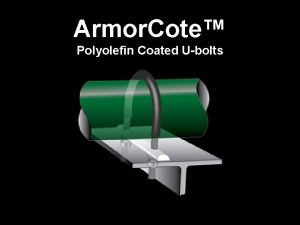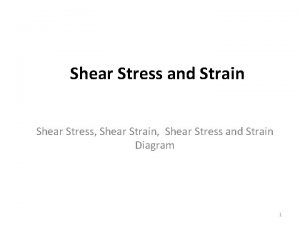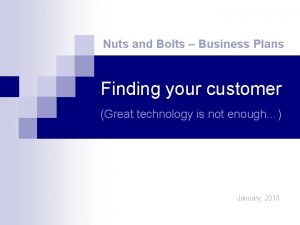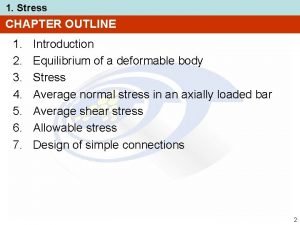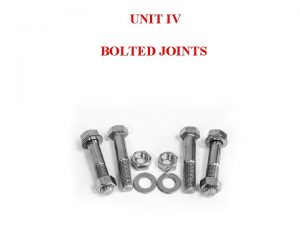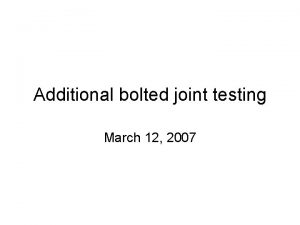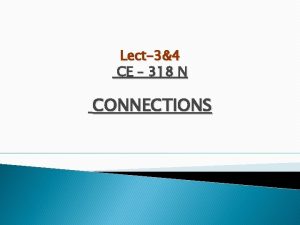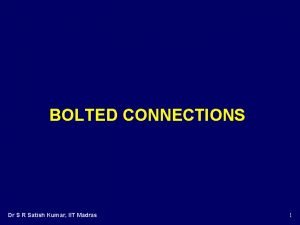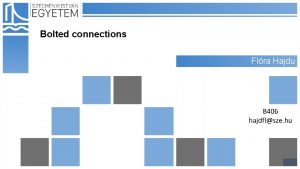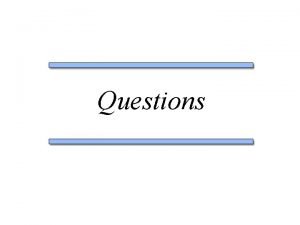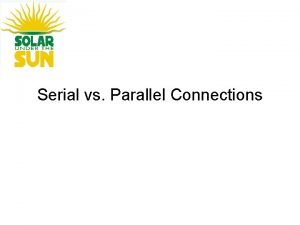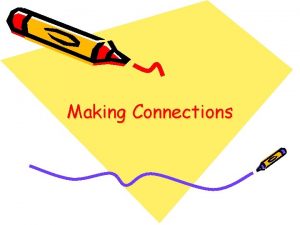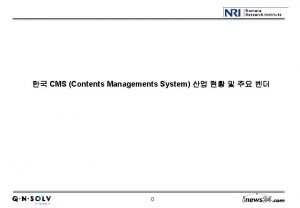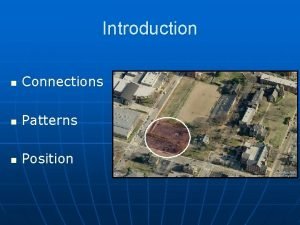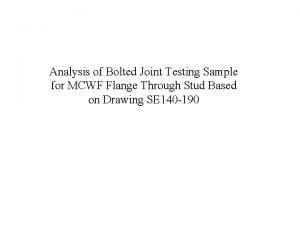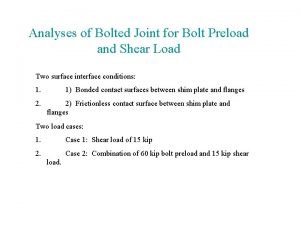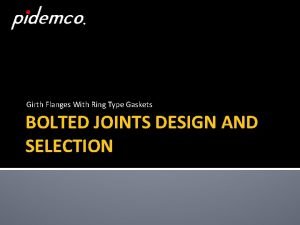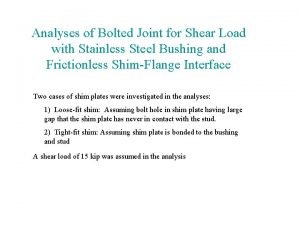BOLTED CONNECTIONS 1 CONTENTS Introduction Bolted Connections Bolts

BOLTED CONNECTIONS 1

CONTENTS • Introduction • Bolted Connections • Bolts and Bolting • Force Transfer Mechanism • Failure of Connections In shear In tension Combined shear and tension Block shear 2

INTRODUCTION • Designed more conservatively than members because they are more complex to analyse and discrepancy between analysis and design is large • In case of overloading, failure in member is preferred to failure in connection • Connections account for more than half the cost of structural steel work • Connection design has influence over member design • Similar to members, connections are also classified as idealised types Effected through rivets, bolts or weld • Codal Provisions 3

TYPES OF CONNECTIONS -! Classification based on type of force in the bolts Single shear Double shear a) Lap Connection b) Butt Connection Shear Connections support (a) (b) Tension Connection and Tension plus Shear Connection 4

BOLTS AND BOLTING Bolt Grade: Grade 4. 6 : - fu = 400 N/mm 2 and fy = 0. 6*400 = 240 N/mm 2 Bolt Types: Black, Turned & Fitted, High Strength Friction Grip Black Bolts: usually Gr. 4. 6, made snug tight, ductile and cheap, only static loads Turned & Fitted; Gr. 4. 6 to 8. 8, Close tolerance drilled holes, 0. 2% proof stress HSFG Bolts: Gr. 8. 8 to 10. 9, less ductile, excellent under dynamic/fatigue loads 5

FORCE TRANSFER MECHANISM (a) Bearing Connection T Bearing stresses T (b) Friction Connection T Clamping Force, PO Tension in bolt Frictional Force T T Clamping Force, PO Bolt Shear Transfer – Free Body Diagram 6

TIGHTENING OF HSFG BOLTS 1) Turn-of-nut Tightening 2) Calibrated Wrench Tightening 3) Alternate Design Bolt Installation 4) Direct Tension Indicator Method (a) Standard (b) Oversized (c )Short Slot (d) Long slot Hole types for HSFG bolts 7

FAILURE OF CONNECTIONS Shear Connections with Bearing Bolts (a) Shearing of Bolts Ps = ps As where As = 0. 78 A (b) Bearing on Bolts Pbb = pbb d t (c) Bearing on Plates Zone of plastification Pbs = pbs d t ½ e t pbs 8

Bearing Type Bolts Shear capacity of bolt Reduction factor in shear for Long Joints Reduction factor in shear for Large Grip Lengths lg = 8 d /(3 d+lg) Reduction factor for Packing Plates pk = (1 - 0. 0125 tpk) 9

Bearing Type Bolts Bearing Capacity of bolt on any ply Vsb = (2. 5 d t fu )/ γmb Tension Capacity Tb =(0. 90 fub An)/ γmb < (fyb Asb (γm 1 / γm 0))/ γmb Bolt subjected to combined shear and tension 10

FAILURE OF CONNECTIONS-1 Shear Connections with HSFG Bolts (a) Slip Resistance Vsf = (µf ne Kh Fo)/ γmf Kh =1. 0 (clearance hole) = 0. 45 (untreated surfaces) Fo= proof load (b) Bearing on Plates Vbf = (2. 2 d t fup ) / γmf < (3 d t fyp)/ / γmf 11

Friction Grip Type Bolting Slip resistance Vsf = (µf ne Kh Fo)/ γmf Where, µf = coeff. of friction (slip factor) as in Table 10. 2 (µf < 0. 55) ne = number of effective interfaces offering frictional resistance to slip Kh = 1. 0 for fasteners in clearance holes = 0. 85 for fasteners in oversized and short slotted holes = 0. 7 for fasteners in long slotted holes loaded parallel to the slot. γmf = 1. 10 (if slip resistance is designed at service load) γmf = 1. 25 (if slip resistance is designed at ultimate load) Fo = minimum bolt tension (proof load) at installation ( 0. 8 Asb fo) Asb = shank area of the bolt fo = proof stress (= 0. 70 fub) Note: Vns may be evaluated at a service load or ultimate load using appropriate partial safety factors, depending upon whether slip resistance is required at service load or ultimate load. 12

TYPICAL AVERAGE VALUES FOR COEFFICIENT OF FRICTION (µf) Treatment of surface Coefficient of friction (µf) Clean mill scale 0. 33 Sand blasted surface 0. 48 Red lead painted surface 0. 1 13

BOLTS UNDER TENSION AND PRYING EFFECT 2 T Bearing type connection T 2 T (b) HSFG Connection To To+ T 2 T Bolt force B k. N Proof Load Po HSFG B Bearing type Applied load 2 T (k. N) ( c) External Tension versus bolt force b n A Q Q T+Q (d) Prying Effect 14

Friction Grip Type Bolting Prying Force = 2 for non-pretensioned and 1 for pretensioned = 1. 5 for LSM be = effective width of flange per pair of bolts 15

DESIGN STRENGTHS FOR BOLTED CONNECTIONS Table 1 Bolt Strengths in Clearance Holes in MPa Bolt strengths Shear strength ps Bearing strength pbb Tension strength pt Bolt grade 4. 6 8. 8 160 375 435 970 195 450 Table 2 Bearing Strengths of Connected Parts in MPa Steel grade ST 42 S Gr. 43 Gr. 50 Bearing bolts pbs 418 460 550 HSFG bolts pbg 650 825 1065 16

Stresses due to Individual forces Combination of stresses Fillet welds Combined bearing, bending and shear 17

GENERAL ISSUES IN CONNECTION DESIGN Assumptions in traditional analysis • Connection elements are assumed to be rigid compared to the connectors • Connector behaviour is assumed to be linearly elastic • Distribution of forces arrived at by assuming idealized load paths • Provide stiffness according to the assumed behaviour • ensure adequate ductility and rotation capacity • provide adequate margin of safety T V d C V e M = Td (a) (b) Standard Connections (a) moment connection (b) simple connection 18

CONTENTS -1 • Analysis of Bolt Groups – Combined Shear and Moment in-Plane – Combined Shear and Moment out-of-plane • Beam and Column Splices • Beam to Column Connections • Beam to Beam Connections • Truss Connections • Fatigue Behaviour 19

TYPES OF CONNECTIONS Classification based on type of resultant force transferred (a) (b) Concentric Connections (a) (b) Moment Connections 20

BEAM AND COLUMN SPLICE Strength, stiffness and ease in erection Assumptions in Rolled-section & Plate Girders (a)Conventional Splice (b) End-Plate Splice Bolted Beam Splice Column Splices – bearing type or HSFG moment splices 21

BEAM-TO-COLUMN CONNECTIONS (a) Simple – transfer only shear at nominal eccentricity Used in non-sway frames with bracings etc. Used in frames upto 5 storeys (b) Semi-rigid – model actual behaviour but make analysis difficult (linear springs or Adv. Analysis). However lead to economy in member designs. (c) Rigid – transfer significant end-moments undergoing negligible deformations. Used in sway frames for stability and contribute in resisting lateral loads and help control sway. 22

BEAM-TO-COLUMN CONNECTIONS (a) e V (b) (c) Simple beam-to-column connections a) Clip and seating angle b) Web cleats c) Curtailed end plate (a) Economical when automatic saw and drill lines are available Check end bearing and stiffness of seating angle Clip angle used for torsional stability (b) If depth of cleats < 0. 6 d design bolts for shear only (c) Eliminates need to drill holes in the beam. Limit depth and thickness t < /2 (Gr. 8. 8) and /3 (Gr. 4. 6) 23

BEAM-TO-COLUMN CONNECTIONS column web stiffeners (a) diagonal stiffener (b) web plate (c) Rigid beam-to-column connections a) Short end plate b) Extended end plate c) Haunched 24

TRUSS CONNECTIONS Splice plate Gusset Plate (a) Apex Connection e support (b) Support connection Truss Connections 25

Thank You 26
- Slides: 26
